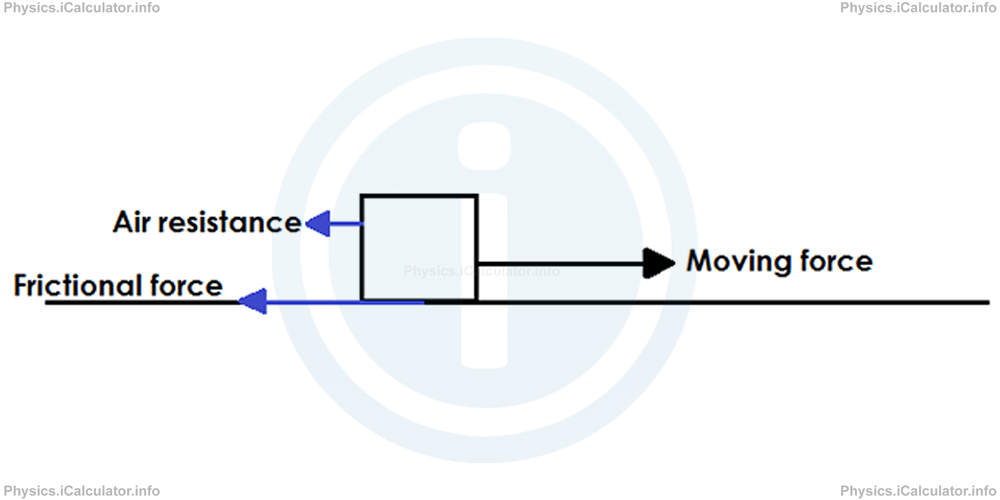Menu
Physics Lesson 4.3.1 - What are Resistive Forces? Types of Resistive Forces
Please provide a rating, it takes seconds and helps us to keep this resource free for all to use
Welcome to our Physics lesson on What are Resistive Forces? Types of Resistive Forces, this is the first lesson of our suite of physics lessons covering the topic of Types of Forces II. Resistive Forces (Frictional Force. Drag). Terminal Velocity, you can find links to the other lessons within this tutorial and access additional physics learning resources below this lesson.
What are Resistive Forces? Types of Resistive Forces
It is clear that the answer of the first question in the Introduction paragraph is "the ball will eventually stop after a while." We know this from practice. But what causes the ball to stop? Is there any resistive force acting in the opposite direction of motion that slows down and eventually stops the moving object?
The answer is YES. The ball is under the effect of two resistive forces, which oppose its motion. They are:
- Frictional force. This is a force produced at the contact area between the ball and the ground. Frictional force has an intermolecular nature. This means that molecules of the two objects in contact resist to the change of structure driven from the friction between them. As a result, the object loses energy during the motion and eventually it stops because all the initial energy of motion (Kinetic Energy) converts into other forms such as heat energy etc. (look at the Physics tutorial "Work and Energy. Types of Energy" and Physics tutorial "Kinetic Energy. Work - Kinetic Energy Theorem."
- Drag. This is a resistive force produced when an object moves inside a fluid (a liquid or a gas). The object tries to displace the fluid's molecules during the motion to make place to itself. As a result, a resistive force is produced by the fluid, which tries to maintain its original position and structure. In the special case, when drag is produced by the air while resisting to a moving object moving through it, this resistive force is known as "air resistance." Therefore, we can say: "Air resistance is a kind of drag."
Look at the figure below.

In the figure, there are two resistive forces, air resistance and frictional force, which try to oppose the moving force. Therefore, the moving force must be at least equal to the frictional force (giving that air resistance does not exist when an object is at rest) to make it move.
You have reached the end of Physics lesson 4.3.1 What are Resistive Forces? Types of Resistive Forces. There are 3 lessons in this physics tutorial covering Types of Forces II. Resistive Forces (Frictional Force. Drag). Terminal Velocity, you can access all the lessons from this tutorial below.
More Types of Forces II. Resistive Forces (Frictional Force. Drag). Terminal Velocity Lessons and Learning Resources
Whats next?
Enjoy the "What are Resistive Forces? Types of Resistive Forces" physics lesson? People who liked the "Types of Forces II. Resistive Forces (Frictional Force. Drag). Terminal Velocity lesson found the following resources useful:
- Resistance Feedback. Helps other - Leave a rating for this resistance (see below)
- Dynamics Physics tutorial: Types of Forces II. Resistive Forces (Frictional Force. Drag). Terminal Velocity. Read the Types of Forces II. Resistive Forces (Frictional Force. Drag). Terminal Velocity physics tutorial and build your physics knowledge of Dynamics
- Dynamics Revision Notes: Types of Forces II. Resistive Forces (Frictional Force. Drag). Terminal Velocity. Print the notes so you can revise the key points covered in the physics tutorial for Types of Forces II. Resistive Forces (Frictional Force. Drag). Terminal Velocity
- Dynamics Practice Questions: Types of Forces II. Resistive Forces (Frictional Force. Drag). Terminal Velocity. Test and improve your knowledge of Types of Forces II. Resistive Forces (Frictional Force. Drag). Terminal Velocity with example questins and answers
- Check your calculations for Dynamics questions with our excellent Dynamics calculators which contain full equations and calculations clearly displayed line by line. See the Dynamics Calculators by iCalculator™ below.
- Continuing learning dynamics - read our next physics tutorial: Types of Forces III (Elastic Force and Tension)
Help others Learning Physics just like you
Please provide a rating, it takes seconds and helps us to keep this resource free for all to use
We hope you found this Physics lesson "Types of Forces II. Resistive Forces (Frictional Force. Drag). Terminal Velocity" useful. If you did it would be great if you could spare the time to rate this physics lesson (simply click on the number of stars that match your assessment of this physics learning aide) and/or share on social media, this helps us identify popular tutorials and calculators and expand our free learning resources to support our users around the world have free access to expand their knowledge of physics and other disciplines.